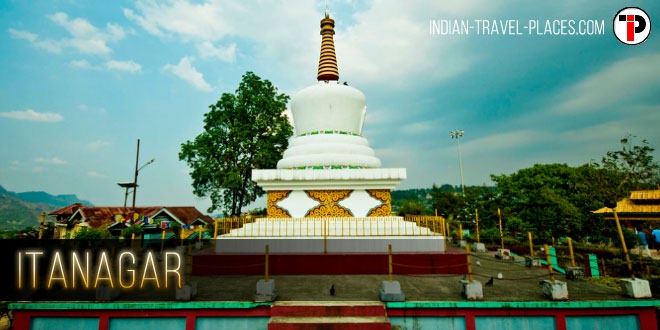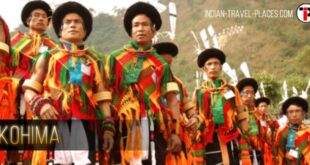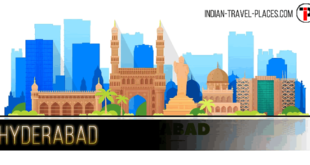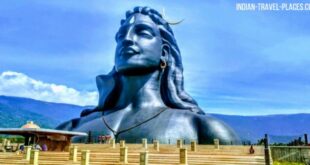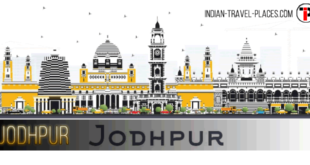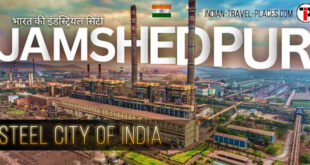| Name: | Itanagar – Land of the Dawn-lit Mountains |
| Location: | Papun Pare District, Arunachal Pradesh, India |
| Climate: | Summers: 40° C (Max), 18° C (Min) | Winters: 12° C (Max), 5° C (Min) |
| Best Time To Visit: | Round the Year |
| Nearest Airport: | Lilabari Airport |
| Railway Station: | Harrmoty Railway Station |
| Must Visits: | Itafort, Buddhist Monastery, Jawaharlal Nehru Memorial Museum, Ganga Lake, Indira Gandhi Park |
| Language Spoken: | Hindi, Assamese, Bengali, English. |
| STD Code: | 0360 |
Itanagar is an enchanting capital city of the northeastern state of Arunachal Pradesh. Sited amidst the foothills of majestic Himalayas, this city has gradually evolved as a thriving tourist destination in northeast region of India. Itanagar comes under the administrative district of Papum Pare and is situated at an average altitude of 440 m above the sea level. Featuring a soothing and pleasant climate all around the year, Itanagar happens to be a round the year destination for tourists. Itanagar is also referred to as “the Land of Dawn lit Mountains” due to its geographical location. Itanagar is blessed by Mother Nature and being at the foothills of Himalayan Ranges; the city offers breathtaking views of the valley and natural landscapes. Thus, it attracts hundreds of nature lovers and tourists (including domestic as well as foreigner).
Being a capital and prominent tourist destination, Itanagar is well linked with other cities of India through roadways and airways. There is a regular helicopter service that connects Itanagar to Guwahati, which in turn, has a full-fledged airport connected to the rest of the states of India. The nearest railhead is 33 kms away. After de-boarding from the train, you need to take a bus or hire a taxi to reach Itanagar. Like some of the other northeastern cities of India, Itanagar also has a rich history which dates back to the 11th century BC when it was the capital of Mayapur during the reign of Jitari Dynasty. Later, during the 14th and 15th century, a historical fort namely Ita-Fort was built. The city has been named after this fort. Post independence, on April 20, 1974, Itanagar was made the capital of Arunachal Pradesh.
Itanagar houses numerous people from numerous locations of India but they all are living with peace and harmony with each other. Therefore, Itanagar is often referred to as “Mini India” of the east. Itanagar’s culture is very much influenced by Tibetan traditions which can be seen in its people’s costumes, food and even rituals. The most prominent factors of the economy of Itanagar are farming and agriculture, although tourism is taking a speedy move in that context as well. Some of the major tourist attractions that you should never miss whist in the city are Ita Fort, Ganga Lake or Gyakar Sinyi, the Namdhapa National Park, Buddhist Monastery, Jawaharlal Nehru Memorial Museum and Indira Gandhi Park. If you are a shopperholic, Itanagar would be nothing less than a paradise, for the city offers authentic and genuine handicrafts.
Best Time To Visit Itanagar
If you thought that a fairytale vacation only exists in travelogues, wait until you hit the state capital of Arunachal Pradesh, Itanagar. Imagine the thrill of waking up in a bamboo-house, with a cup of steaming hot herbal tea in hand and a magnificent view of splendiferous mist-clad mountains and gurgling streams laid open before your eyes. Itanagar truly spells luxury, but of a different kind. Posited on the far northeastern corner of the India map, Itanagar’s charms remains unsullied by the glitz and gloss of city life. Fondly referred to as the ‘Land of Dawn-lit Mountains’, Itanagar derives its name from the ancient Ita Fort, which is one of the major landmarks in the region. Home to tribes like Monpas, Nishis, Wancho and Mishmis, this northeastern city boasts of a strong Tibetan influence. Also, boasting of a beguiling biodiversity that beckons nature enthusiasts from all across the country, this green paradise is truly every trekkers dream destination. It is impossible to sum up the beauty of Itanagar in words. To explore the real resplendency of the state, you will have to hit the town on your own. To make your trip to Itanagar a success, knowing the best time to visit would just be a great idea. To know more on this, read on.
When To Go
Climate
Itanagar experiences a mild, pleasant climate all throughout the year. Situated at an altitude of 440 meters, this hill resort is endowed with a subtropic and alpine type of climates. Hence, the city enjoys a moderate temperature around the year. The summer months of May and June are usually balmy, though, at times, the mercury level can skyrocket to 410 C on extremely sweltering days. Itanagar receives rampant showers during the months of July, August and September, with temperature levels wavering between 170 C – 300 C. The post-monsoon months, especially the winters are really acrid and cold here.
Best Time To Visit Itanagar
The hills of Itanagar are the ideal place for vacationing, trekking down the mist-clad greens and indulging in its many adventure activities. However, to experience all that, it is important to time your visit right. Luckily, the weather conditions here remain agreeable around the year. Nevertheless, the high level of humidity during the summers and occasional snowfall during the winters can topple your travel plans and leave you locked in the close confines of your lodges. To avoid that, visit Itanagar anytime between October to March, when the weather is mildly nippy but not overly cold. What’s more, if you are lucky, you can experience snowfall and maybe even get a chance to make your own snowman.
Places To See
The capital city of Arunachal Pradesh woos you with its impeccable charms and matchless beauty. Nestled on the shores of the Ganga Lake, a visit to Itanagar is a treat for the senses. Apart from basking in its natural splendor, don’t forget to hit the archaeological sites, state museums and handloom shops while you are in the city for a true Itanagar experience. What’s more, from Itanagar, you can also plan a weekend jaunt to the neighboring places of Tawang and Bomdila, which are just a few hours’ drive away from the city.
History:
Located in the state of Arunachal Pradesh, Itanagar is the capital of the state and an important tourist spot in this region. Strategically situated at the feet of the snow caped Himalayan Mountains, Itanagar falls under the Papum Pare district. The earliest citation of the place dates back to the ancient epic sagas of Ramayana and Mahabharata. In the past, several tribes that were prominent in the region such as Nyishis, Adis, Galos, Apatanis and the Miri’s ruled Itanagar. Today, however, the place sees a very small population of the decedents of these ethnic groups. During the 16th century, the Ahom Kingdom ruled the place. In the 16th century, the tribes belonging to the nearby region captured the place. The Ahom dynasty ruled the place with an iron hand until British annexed it. Later, the place underwent territory issues with China, which continued until 1987. Read the article to know more about the history of Itanagar.
Itanagar History
Early Existence
According to a legend, Itanagar was believed to be the home to many Hindu mythological characters like Princess Rukmini, King Bhismaka and Lord Parashuram. In fact, the place has found frequent citation in the heroic tales of Ramayana, Mahabharata and other Vedic texts. On the other hand, historians believe that many indigenous ethnic groups, that trace back their roots to the Tibeto-Burman tribes, ruled the place in the past. Since there is no concrete proof on the origins of this region, speculations on their origin is primarily based on the traditions and food habits of the local people.
Ahom Kingdom
The only historical record in this province is the chronicles of the Ahom Dynasty belonging to the 16th century. The Ita Fort is the best example of the powerful Ahom rule in Itanagar. According to the records maintained by tribes of Monpa and Sherdukpen, the Monpa chiefs ruled the northwestern part of the state. The Monpa chieftains are said to be a part of the Monyul Empire. The Monyul dynasty flourished during 500 BC. Save for a few sections on the northern frontier that was captured and ruled by Tibet and Bhutan tribes, the remaining parts of the region was controlled by the Ahoms The place continued to be administered by the Ahoms until the British seized the place in the year 1858.
British Rule
When the state of Arunachal Pradesh fell in the hands of the British, the English administration also faced several border issues. In the year 1913-14, the East Indian Company made efforts to resolve the issue by elucidating the border of British India and Tibet. Sir Henry McMahon drew up 550 miles as a boundary line for British India, which was called as the McMahon line. The proposal was later unaccepted by the Chinese, which led to further disagreements.
Post-Independence
After independence, the region once again came under conflict with the Chinese government. People’s Republic of China refused to give up Tibet, thereby, heightening the differences between the two nations. India declaring McMahon line as the official boundary and China refusing to accept or reorganize the line further worsened the matter. In the year 1954, the NEFA was created and the issue died down temporarily. A decade later, the matter was awakened again by the People’s Republic of China, which led to war in the year 1962. The reason for the Sino-Indian War of 1962 is still not clear. However, the war helped China to capture most parts of the state of Arunachal Pradesh. India, on the other hand, closed all trade activities with Tibet, while Arunachal Pradesh became a union territory in 1972. It was only in 1987 that the Indian government acknowledged Arunachal Pradesh as another state of Independent India.
How To Reach Itanagar
The capital city of Arunachal Pradesh, Itanagar, is a melange of diverse tribes and terrains that lends this far-flung northeastern city its unparalleled charm. The sprawling greens, spectacular hills, swooshing lakes and salubrious weather makes Itanagar a dream stop for the wanderlusts. Sashaying matchless natural extravagance and a mind-boggling biodiversity, Itanagar is inarguably one of northeast’s biggest attractions. The bucolic cultures and scenic landscape makes it a potential destination for the backpackers. However, getting to Itanagar is not easy and entails government permits. So, before you head out for Itanagar, make sure you avail stay permits in advance. All said and done, Itanagar is endowed with good transportation network that makes this city easily accessible for the tourists. Apart from the airways and the railways, Itanagar is also gifted with an impressive network of roads, which connects the city to all the neighboring cities and states. If you plan to travel to Itanagar, then knowing how to reach the city and the best way to move around will make sense to you. Scroll down this write-up for more on dope on this.
Traveling
By Air
Situated on the northernmost corners of the country, Itanagar is not endowed with an airport of its own. However, it can be easily accessed by air via other neighboring airports. The closest airport to Itanagar is located in Lilabari, North Lakhimpur in Assam. Lilabari is about 67km from Itanagar and 53km away from Naharlagun. This airport is well connected to Guwahati by regular flights. Apart from these, there are domestic helicopters like Pawan Hans that provides helicopter service between Itanagar and Guwahati, three days in a week. The helicopter also connects cities like Guwahati, Dibrugarh (Mohanbari) and Itanagar to Tawang, Ziro, Roing, Daporijo, Along, Tezu, Pasighat, Anini, and Khonsa.
By Rail
Itanagar does not have a railway station of its own. The nearest railway head is placed in Harmuty in Assam, which is about 33km away from Itanagar. Another railway station is located at North Lakhimpur in Assam, which is about 60 km away from Itanagar. The railway station leads to Kamakhya Railway Station in Guwahati, which is connected to Silchar, Kolkata, and Siliguri etc.
By Road
An impressive network of roads connects Itanagar to the important cities and other neighboring states of Assam, Manipur, Mizoram, Tripura and Meghalaya. Motorable roads link Itanagar to Guwahati (429kms), Bomdila (350kms), Kolkata (1611kms), North Lakhimpur (64kms), Siliguri (942kms), and Shillong (495kms) and so on. Overnight buses connect Itanagar to Guwahati, Shillong and Imphal. Arunachal State Transport runs an extensive bus service throughout the state. However, being a protected area, the tourists must obtain entry permits before they head out.
Getting Around
To get in and around the city, you can avail the cycle rickshaws, auto rickshaws and taxis that are the most preferred form of local transport here. Itanagar is basically a very small city, and tourists can visit all the places of interest in a single day by covering the entire region by foot.
Shopping:
Itanagar, swathed by rich flora and fauna, is the first place in India to witness the glowing rays of the sun and is fondly known as the ‘Land of Dawn-Lit Mountains’. Apart from spotting tribal communities, you can also find enchanting tea gardens, apple orchards and magnificent monuments here. Visiting Itanagar is like a refreshing break as the place buzzes with many untouched and unspoiled virgin spots. What’s more, the pleasant weather makes the place scenic and a year round destination. Itanagar, although doesn’t have swanky malls and plush complexes, the roadside markets and small shops are enough to make your shopping experience rich and complete. Some of the popular shopping items are woolen shawls, wooden articles, bamboo baskets and not to forget, the marvelous Tibetan Buddhist paintings or the ‘thangkas’. While dealing with the vendors, do bargain hard as their ability to trick tourists by charging exorbitantly prices scores high. Itanagar can be easily reached from any part of India, as there are various transportation services always at your service. You can rely on cycle or auto rickshaws and taxis to move in and around Itanagar. Given below is the detailed list of the top shopping places in Itanagar. Scroll down the article to explore.
Things To Buy In Itanagar
Thangkas
Thangkas or the Tibetan Buddhist paintings are found in plenty in Itanagar. There are many shops and roadside stalls selling Thangkas in different designs at reasonable prices. The city is scattered with a spate of emporiums and handicraft centers that houses artifacts and has an amazing assortment of Tibetan paintings. These elegant looking paintings are made on cloth with the help of vegetable dyes or gold.
Woodcarvings
Exotic wood figurines and sculptures are other popular selling souvenirs in Itanagar. Carved wooden objects of animals and birds can also be spotted in some of the shops. Besides art connoisseurs, even tourists stuff their travel bags with woodcarvings found in narrow bustling bazaars of the city.
Bamboo And Cane Items
Wonderful bamboo and cane products like chairs, flower vases, baskets, lamps, crafted bamboo mats, wall hangings sell like hot cakes in Itanagar. Each souvenir shop in the city has a stock of bamboo and cane items. Most of these delicately woven bamboo items are created by skilled artisans.
Woolen Products
The demand for buying woolen shawls, sweaters, caps and carpets in Itanagar goes up especially during the wintertime. To buy the best quality woolen products, head over to Bomdila, a beautiful small town situated near the main city. Besides, you can also shop for some traditional and colorful masks there. Many local buses and other transport modes ply from Itanagar until Bomdila at frequent intervals.
Fruit Bowls
Eye-catching fruit bowls made out of Monpa wood is also one of the topnotch selling souvenirs in Itanagar. Besides bowls, you can also find dishes and cups made of this spectacular wood that are created in bulk by accomplished wood carvers. So, make sure to buy these fascinating fruit bowls that make perfect gifting items for your near and dear ones.
Sarongs
The bright and fashionable sarongs worn by both men and women are a rage in Itanagar. Many roadside vendors and street stalls are loaded with sarongs. Besides sarongs, don’t forget to splurge on attractive bangles and bead ornaments that are a must add-on to your shopping cart.
Places To See In Itanagar
With its immaculate natural beauty and ragbag of different tribes, Itanagar is truly the cultural melting pot of India. Engulfed by snow-capped mountains of the Himalayan range and the chilling water trails of the river Brahmaputra, Itanagar stuns you with its simplicity and uniqueness. The hospitality and affability of the local natives along with the pleasant weather conditions around the year has earned the city the tag of an important tourist destination in the region. Apart from its scenic location, the city also boasts of being home to the ancient Ahom warriors. The Ita Fort takes you back in time to the 14th century that reminds you of the powerful rule of the Ahom Dynasty. The tranquility of the Ganga Lake is a sight to behold. A visit to the Namdhapa National Park lets you catch a glimpse of the local fauna that is distinctive to this mountain range. Itanagar is also an important archaeological site due to its existence of diverse heritage structures within the city limits. Itanagar has many unexplored layers that weave a mysterious aura to it. Scroll down further to read a detailed description on the various tourist attractions in Itanagar.
Tourist Attractions
Ganga Lake
Situated just 6 km away from the heart of Itanagar, this water body, posited on the edge of a hilly region is flanked by thick and dense vegetation that lends the place its magical charm. As you travel down the winding roads to reach this place, you will be amazed to find some breathing taking vistas. Striking orchids, towering wooden trees, clear waters of the pond and magnificent scenic views of the mountains are some of the things that you can look forward to while visiting Ganga Lake. The local tourism board has spruced up the lake well enough to lure travelers to visit this enchanting place. If you are in Itanagar, then a visit to Ganga Lake is a must.
Ita Fort
The Ita Fort is one of the most important architectural sites in the city. In fact, the city of Itanagar draws its name from the Ita Fort that is located in the centre of Papum Pare district in the state. The citadel is said to be erected by the Ahom rulers who resided in this region during the 14th and the 15th century. This impressive, irregularly shaped building is constructed from thousands of bricks and holds a commanding presence over the capital city. This mammoth sized fort is believed to have three different gates located on the western, eastern and southern side of the fort walls. Ita Fort is surely one of the most exceptional structural sites to look forward to in Itanagar.
Buddhist Temple
Itanagar is replete with monasteries that resonate with spirituality. Buddha Vihar located within the vicinity of the city is one such religious cloister. The temple’s exteriors bear a close resemblance to typical Buddhist structures. The golden structure stands as a striking contrast against the velvety green carpet of the sprawling lawn. As you stroll down the quite corridors of the temple, you are likely to find interesting Buddhist artifacts of religious significance. The Buddha Vihar is not only an important religious pilgrimage but also a popular tourist destination in the state.
Namdhapa National Park
Itanagar holds quite a distinction for housing an intriguing plethora of biodiversity and has quite a few natural parks to its name. One of the unmissable sanctuaries in the city is the Namdhapa National Park that is world-famous for housing rare varieties of large feline like the snow leopards and the clouded leopards. And the best thing is that you don’t have to wait hours to spot one. Just take a safari ride down the park and you will spot the ounces aimlessly wandering around. This national park is also an asylum to other animals like black bear and the red panda. If you are a wildlife photographer or even a wildlife enthusiast, then Namdhapa is a must visit.
Jawaharlal Nehru State Museum
A trip to the state museum provides an educative tour on the local tribes and culture of the state. The museum hosts a wide collection of wooden carvings, musical devices, variety of fabrics and other handmade artifacts made by the local artisans. The place also displays a wide variety of items, unearthed from the surrounding areas in the state and the Ita Fort. The museum also hosts seminars on traditional uses of cane. The Jawaharlal Nehru State Museum also has a library with a wide collection of books that provide useful information on diverse topics and is open to the public.
 ITP Indian Travel Places: Food, Travel, Tourism Business Events and Trade Shows
ITP Indian Travel Places: Food, Travel, Tourism Business Events and Trade Shows
